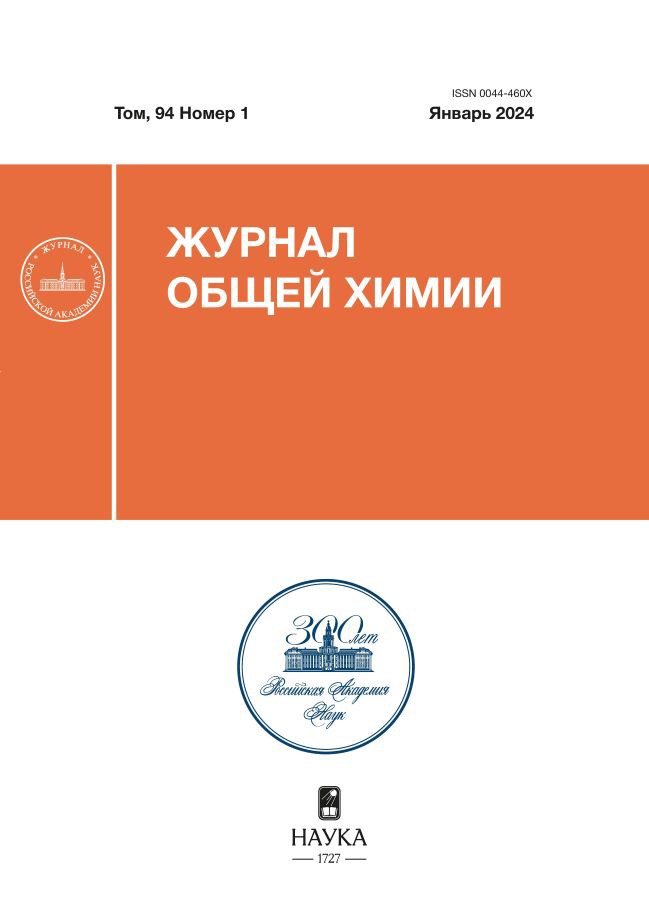Synthesis of Phosphoisosteres of Amyloid Dipeptide Components
- Authors: Golovash S.R.1, Ivanov D.E.1, Borodachev A.V.1, Shestov V.I.1, Dmitriev M.E.1, Ragulin V.V.1
-
Affiliations:
- Institute of Physiologically Active Compounds, Federal Research Center of Problems of Chemical Physics and Medicinal Chemistry of the Russian Academy of Sciences
- Issue: Vol 94, No 1 (2024)
- Pages: 98-104
- Section: Articles
- URL: https://cardiosomatics.ru/0044-460X/article/view/667244
- DOI: https://doi.org/10.31857/S0044460X24010081
- EDN: https://elibrary.ru/HKVRCB
- ID: 667244
Cite item
Abstract
A simple and effective method was proposed for the synthesis of new phosphinic peptides in free form, structural isosteres of the dipeptide components of beta-amyloid (Aβ42), potential inhibitors of zinc-metalloproteinases.
Full Text
About the authors
S. R. Golovash
Institute of Physiologically Active Compounds, Federal Research Center of Problems of Chemical Physics and Medicinal Chemistry of the Russian Academy of Sciences
Email: rvalery@dio.ru
Russian Federation, Chernogolovka
D. E. Ivanov
Institute of Physiologically Active Compounds, Federal Research Center of Problems of Chemical Physics and Medicinal Chemistry of the Russian Academy of Sciences
Email: rvalery@dio.ru
Russian Federation, Chernogolovka
A. V. Borodachev
Institute of Physiologically Active Compounds, Federal Research Center of Problems of Chemical Physics and Medicinal Chemistry of the Russian Academy of Sciences
Email: rvalery@dio.ru
ORCID iD: 0000-0002-3458-5129
Russian Federation, Chernogolovka
V. I. Shestov
Institute of Physiologically Active Compounds, Federal Research Center of Problems of Chemical Physics and Medicinal Chemistry of the Russian Academy of Sciences
Email: rvalery@dio.ru
Russian Federation, Chernogolovka
M. E. Dmitriev
Institute of Physiologically Active Compounds, Federal Research Center of Problems of Chemical Physics and Medicinal Chemistry of the Russian Academy of Sciences
Email: rvalery@dio.ru
ORCID iD: 0000-0001-8870-195X
Russian Federation, Chernogolovka
V. V. Ragulin
Institute of Physiologically Active Compounds, Federal Research Center of Problems of Chemical Physics and Medicinal Chemistry of the Russian Academy of Sciences
Author for correspondence.
Email: rvalery@dio.ru
ORCID iD: 0000-0002-3967-1034
Russian Federation, Chernogolovka
References
- Collinsova M., Jiracek J. // Curr. Med. Chem. 2000. Vol. 7. N 6. P. 629. doi: 10.2174/0929867003374831
- Dive V., Georgiadis D., Matziari M., Makaritis A., Beau F., Cuniasse P., Yiotakis A. // Cell. Mol. Life Sci. 2004. Vol. 61. P. 2010. doi: 10.1007/s00018-004-4050-y
- Mucha A. // Molecules. 2012. Vol. 17. P. 13530. doi: 10.3390/molecules171113530
- Georgiadis D., Dive V. // Top. Curr. Chem. 2015. Vol. 360. P. 1. doi: 10.1007/128_2014_571
- Zinc Metalloproteases in Health and Disease // Ed. N.M. Hooper. London: Taylor and Francis, 1996. P. 153.
- Hori M., Nishida K. // Cardiovasc. Res. 2009. Vol. 81. N 3. P. 457. doi: 10.1093/cvr/cvn335
- Whittaker M., Ayscough A. // Celltransmissions. 2001. Vol. 17. N 1. P. 3.
- Pirad B., Matter H. // J. Med. Chem. 2006. Vol. 49. N 1. P. 51. doi: 10.1021/jm050363f
- Dafnis I., Argyri L., Chroni A. // Neuroscience. 2018. Vol. 394. P. 144. doi: 10.1016/j.neuroscience.2018.10.026
- Sun X., Chen W.-D., Wang Y.-D. // Front. Pharmacol. 2015. Vol. 6. P. 1. doi: 10.3389/fphar.2015.00221
- Xiong Z.M., Kitagawa K., Nishiuchi Y., Kimura T., Nakamura T., Inagaki C. // Life Sci. 2009. Vol. 84. P. 132. doi: 10.1016/j.lfs.2008.11.011
- Xiong Z.M., Kitagawa K., Nishiuchi Y., Kimura T., Inagaki C. // Neurosci. Lett. 2007. Vol. 419. N 3. P. 247. doi: 10.1016/j.neulet.2007.04.022
- Musiek E.S., Holtzman D.M. // Neuroscience. 2015. Vol. 18. P. 800. doi: 10.1038/nn.4018
- Dafnis I., Argyri L., Sagnou M., Tzinia A., Tsilibary E.C., Stratikos E., Chroni A. // Sci Rep. 2016. Vol. 6. P. 30654. doi: 10.1038/srep30654
- Argyri L., Dafnis I., Theodossiou T.A., Gantz D., Stratikos E., Chroni A. // J. Biol. Chem. 2014. Vol. 289. P.12931. doi: 10.1074/jbc.M113.538124
- Дмитриев М.Э., Рагулин В.В. // ЖОХ. 2015. Т. 85. Вып. 9. С. 1511; Dmitriev M.E., Ragulin V.V. // Russ. J. Gen. Chem. 2015. Vol. 85. N 9. P. 2091. doi: 10.1134/S1070363215090121
- Dmitriev M.E., Golovash S.R., Borodachev A.V., Ragulin V.V. // J. Org. Chem. 2021. Vol. 86. N 1. P.593. doi: 10.1021/acs.joc.0c02259
- Rozhko L.F., Ragulin V.V. // Amino Acids. 2005. Vol. 29. P.139. doi: 10.1007/s00726-005-0194-9
- Dmitriev M.E., Ragulin V.V. // Tetrahedron Lett. 2010. Vol. 51. N 19. P. 2613. doi: 10.1016/j.tetlet.2010.03.020
- Dmitriev M.E., Ragulin V.V. // Tetrahedron Lett. 2012. Vol. 53. N 13. P. 1634. doi: 10.1016/j.tetlet.2012.01.094
Supplementary files











